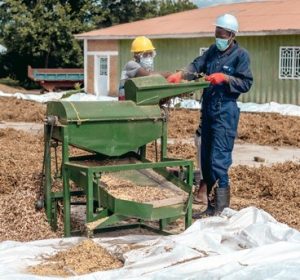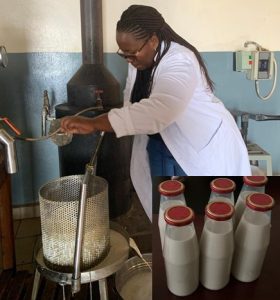Youth-led Soybean Enterprise

The President of the Democratic Republic of Congo (DRC) recently called for a “Soybean Revolution” and invited the African Agricultural Leadership Institute (AALI) and its Agricultural Transformation Agenda to lead in this nationwide effort. AALI commissioned the Youth Brigade (Brigade des Jeunes) to participate in several activities along the soybean value chain. First the Brigadiers assisted in the introduction and harvest of improved varieties of soybean grown on 67 ha of land at the state farm in Rizizi. These seeds are high in protein and resistant to Asian rust (see Technologies 1 and 6). Brigadiere assistance included the introduction and use of small-scale threshing machines that increased the speed and quality of seed recovery of dried plants harvested from the field. The Brigadiers also provided grain moisture meters to ensure that packaged seed met the 12% moisture threshhold, woven polythene sacks that allow these seed to “breathe” and hand-held stitchers that closed the sacks quickly and efficiently. These approaches were new to local cooperators and one set of equipment was left behind for future use. In all, about 100 tons of improved seed were harvested and readied for outreach efforts the following season.

Another action area involves production of rhizobial inoculants (see Technology 4). No such inoculants are produced in DRC and the importation of inoculants is difficult, expensive and time consuming. IITA provided the elite rhizobium contained in its NoduMax product. Youth prepared carrier material from a local source and developed an innovative brothing procedure. Actions are supervised by a professor at a nearby university to ensure that quality control procedures are in place. The resulting inoculant product is being tested against an imported product, and will then be manufactured in sufficient quantity to innoculate the soybeans produced in Ruzizi.

Some of the soybeans produced in Ruzizi are also being used for value added processing by the Brigadiers. The first to value adding applications involve the production of soy dairy products and the blending of animal feeds (see Technologies 8 and 11). For the dairy, soybeans are soaked, boiled and pressed using locally available equipment. The Brigadier’s exploratory unit is able to produce xx liters of soymilk per day, and their methods wil soon be introduced to other Brigadier Chapters being estabished across the country. Maize and soybean constitute the majority of blended animal feeds, including those intended for poultry and fish. Simple milling and blending procedures are employed that may be replicated elsewhere. One early product is feed intended for fish fry and fingerlings in support of the Brigadier’s parallel efforts to establish a network of fish hatcheries producing tilapia and catfish.

Clearly, youth have an important role play in the support of soybean value chains. The production and distribution of improved soybean seed is an obvious starting point, and as the crop is self-polinating and well suited to community-based seed systems, youth have an obvious role to play. Training educated youth in the production of biofertilizers, such as soybean inoculants, is an investment in agricultural modernization. Finally, soybeans are processed at a variety of levels, from cottage industry to agro-industrial, and preparing youth to improve human and animal nutrition through engagement with this porcessing is a means toward food and nutritional security across Africa.

